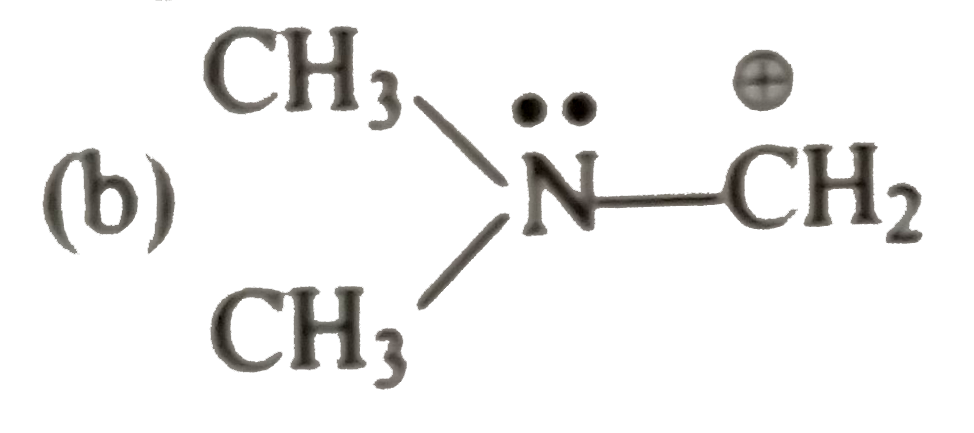Which of the following cation would have greatest stability?
CH3−⋅⋅S⋅⋅−⊕CH2

CH3−⋅⋅O⋅⋅−⊕CH2
:⋅⋅F⋅⋅−⊕CH2
The correct Answer is:B
To determine which cation would have the greatest stability, we need to analyze the nature of the cations provided and the factors that contribute to their stability.
1. Identify the Cations: List the cations that are being compared. For this example, let's assume we have the following cations:
- A: C3H+7 (Propylium)
- B: C2H5NH+3 (Ethylammonium)
- C: C2H5OH+2 (Ethylhydronium)
- D: C2H5F+ (Ethylfluoridinium)
2. Consider Electronegativity and Lone Pair Donation:
- The stability of cations can be influenced by the presence of electronegative atoms nearby that can donate lone pairs to stabilize the positive charge.
- The order of electronegativity from highest to lowest for common elements is: Fluorine > Oxygen > Nitrogen > Sulfur.
3. Analyze Each Cation:
- Cation A: The propylium cation has no electronegative atoms nearby to stabilize the positive charge.
- Cation B: The ethylammonium cation has nitrogen, which can donate a lone pair to stabilize the positive charge. Nitrogen is less electronegative than oxygen and fluorine, making it a good donor.
- Cation C: The ethylhydronium cation has oxygen, which is more electronegative than nitrogen. Oxygen can also donate a lone pair, but it is less effective due to its high electronegativity.
- Cation D: The ethylfluoridinium cation has fluorine, which is very electronegative and does not donate its lone pair effectively to stabilize the cation.
4. Determine Stability:
- Cation B (Ethylammonium) is the most stable because nitrogen can effectively donate its lone pair to stabilize the positive charge, while cation C (Ethylhydronium) is less stable due to the high electronegativity of oxygen, and cation D (Ethylfluoridinium) is the least stable due to fluorine's reluctance to donate its lone pair.
5. Conclusion: The cation with the greatest stability is B: Ethylammonium C2H5NH+3.
- A: C3H+7 (Propylium)
- B: C2H5NH+3 (Ethylammonium)
- C: C2H5OH+2 (Ethylhydronium)
- D: C2H5F+ (Ethylfluoridinium)
- The stability of cations can be influenced by the presence of electronegative atoms nearby that can donate lone pairs to stabilize the positive charge.
- The order of electronegativity from highest to lowest for common elements is: Fluorine > Oxygen > Nitrogen > Sulfur.
- Cation A: The propylium cation has no electronegative atoms nearby to stabilize the positive charge.
- Cation B: The ethylammonium cation has nitrogen, which can donate a lone pair to stabilize the positive charge. Nitrogen is less electronegative than oxygen and fluorine, making it a good donor.
- Cation C: The ethylhydronium cation has oxygen, which is more electronegative than nitrogen. Oxygen can also donate a lone pair, but it is less effective due to its high electronegativity.
- Cation D: The ethylfluoridinium cation has fluorine, which is very electronegative and does not donate its lone pair effectively to stabilize the cation.
- Cation B (Ethylammonium) is the most stable because nitrogen can effectively donate its lone pair to stabilize the positive charge, while cation C (Ethylhydronium) is less stable due to the high electronegativity of oxygen, and cation D (Ethylfluoridinium) is the least stable due to fluorine's reluctance to donate its lone pair.
Topper's Solved these Questions
- GENERAL ORGANIC CHEMISTRYBOOK - HIMANSHU PANDEYCHAPTER - GENERAL ORGANIC CHEMISTRYEXERCISE - Level 2 (Q.51 To Q.75)
25 Videos
- GENERAL ORGANIC CHEMISTRYBOOK - HIMANSHU PANDEYCHAPTER - GENERAL ORGANIC CHEMISTRYEXERCISE - Level 2 (Q.76 To Q.100)
25 Videos
- GENERAL ORGANIC CHEMISTRYBOOK - HIMANSHU PANDEYCHAPTER - GENERAL ORGANIC CHEMISTRYEXERCISE - Level 2 (Q.1 To Q.25)
25 Videos
- CHEMISTRY IN DAILY LIFEBOOK - HIMANSHU PANDEYCHAPTER - CHEMISTRY IN DAILY LIFEEXERCISE - Integer Answer Type Problems
7 Videos
- HALIDESBOOK - HIMANSHU PANDEYCHAPTER - HALIDESEXERCISE - Subjective Type Problems
10 Videos
Similar Questions
Knowledge Check
Which of the following cation would have greatest stability?
ACH3−S−CH+2B(CH3)2NCH+2CCH3−O−CH+2DF−CH+2Which one of the following cross would have ratio
AT+RRx ttrrBTTRR x ttrrCTrans segmentDTrRR xTTWhich of the following would have oxysomes:
AmitochondriaBperoxisomesCribosomesDnucleus
Which of the following solutions would have same pH ?
View SolutionEach of us is part of the ongoing evolution of the species which of the following occurrences would have the gretest impact on the future bilogical evolution of the human population?
View SolutionEach of us is part of the ongoing evolution of the species which of the following occurrences would have the gretest impact on the future bilogical evolution of the human population?
View SolutionWhich of the following monomers has greatest ability to undergo cationic polymerisation?
View SolutionWhich of the following is cationic complex?
View Solution

